Renewable energy development perspectives
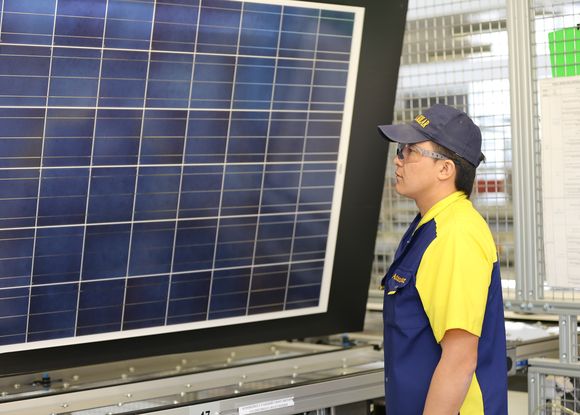
530
13 July 2016
The interest to renewable energy sources are increasing globally because of growing demand for energy, reduction of proven reserves of many fossil fuels, the motivation of governments to reduce dependence on imported raw materials, as well as environmental safety concerns. Over 138 countries have designated targets for the development of renewable energy at the national level.
In 2015, global renewables capacity (including hydropower) reached 1,849 GW, 57.5% of which is hydropower capacity. Last year, almost 147 GW of renewable power capacity was added, the largest annual increase ever. This growth occurred despite tumbling global prices for all fossil fuels, ongoing fossil fuel subsidies and other challenges facing renewables, including the integration of rising shares of renewable generation, policy and political instability, regulatory barriers and fiscal constraints.
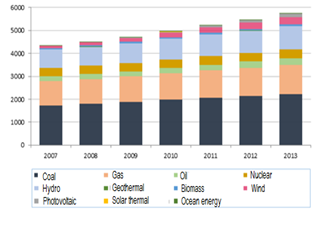
As a result of continuous improvement of renewable energy technologies and infrastructure, as well as more efficient power transmission, it is expected that the total capacity of renewable energy (excluding hydropower) is expected to increase by 2 times to 1,194 GW by 2020, and by 5 times to 3,400 GW by 2030. Furthermore, onshore wind power and solar photo-voltaic (PV) will be the major renewables (87% of total renewable energy, excluding hydropower). Other types of renewable energy such as the concentrated solar power, bioenergy, geothermal, and others are at an early stage of development and/or commercialization. A significant increase in their impact to global energy sector is not expected in the next 10 years.
As a result of continuous improvement of renewable energy technologies and infrastructure, as well as more efficient power transmission, it is expected that the total capacity of renewable energy (excluding hydropower) is expected to increase by 2 times to 1,194 GW by 2020, and by 5 times to 3,400 GW by 2030. Furthermore, onshore wind power and solar photo-voltaic (PV) will be the major renewables (87% of total renewable energy, excluding hydropower). Other types of renewable energy such as the concentrated solar power, bioenergy, geothermal, and others are at an early stage of development and/or commercialization. A significant increase in their impact to global energy sector is not expected in the next 10 years.
Top 5 countries by renewable energy capacity
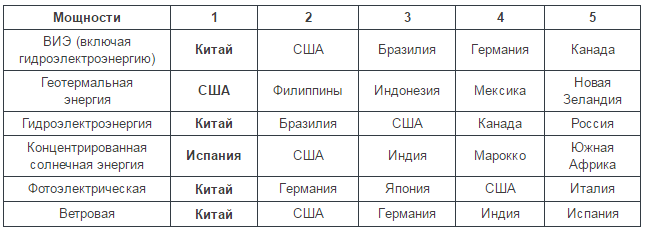
Source: Renewables Global Status Report 2016
Kazakhstan power industry is characterized by a high concentration of energy generating capacity - 90% of all electricity produced is generated by thermal and gas turbine power plants (coal, gas), and 8.4% by hydroelectric power plants. Kazakhstan is self-sufficient in terms of electricity, and import is insignificant. Southern and western regions of Kazakhstan import electricity and northern part exports to Russia (Pavlodar and East Kazakhstan region).
The total potential capacity of renewable energy sources in Kazakhstan is very significant and estimated at more than 1tln kWh per year, which exceeds the current demand for electricity 91 billion kWh for 10 times.
The most promising renewable energy sources are the following:
- wind power - technical potential of 929 billion kWh per year,
- hydropower - technical potential of 62 billion kWh per year, 8.0 billion kWh per year of which is the potential of small hydro power plants, and
- solar energy potential is estimated at 2.5 billion kWh per year.
As for 1Q16 the share of renewable energy (solar, wind, small hydropower) in electricity generation was 0.8%, 58% of which are small hydropower. There are 26 projects at various stages of implementation for the development of new renewable energy facilities with a total design capacity of 708 MW (wind power plants - 9 projects with a total capacity of 410.5 MW, hydropower plants - 15 projects with a total capacity of 247 MW, solar power plants - 2 projects with a total capacity of 50.5 MW). The quasi-state sector accounts for about 19% (around 132 MW) of the total planned capacities.
In accordance with the Activities Plan for renewable energy development in Kazakhstan for 2013-2020, by end-2020, there is a plan to put into operation about 106 renewable energy facilities with a total installed capacity of 3,104.5 MW, which accounts for 12.7 % of total country capacity. It is planned that 60% of all renewable energy capacity will be wind power:
- 34 wind power plants (1,787 MW),
- 41 hydropower plants (539 MW),
- 28 solar power plants (713.5 MW), and
- 3 biopower plants (65 MW).
Thus, the most efficient renewable energy technology (excluding hydropower) would be the wind power due to the relatively low levelized cost of electricity and the ability to generate more electricity per unit of power. Hydropower has traditionally been considered as an effective technology. However, there is a concern of possible water scarcity. It is expected that by 2040 (12.2 cubic km.), Kazakhstan might face a significant shortage of water resources in the amount of 50% of the demand. It is necessary to develop mechanisms to facilitate the integration of variable renewable energy sources by increasing the flexibility of the energy system: the flexible power plants, grid infrastructure, and electricity storage technologies from the demand side.
In 2015, global renewables capacity (including hydropower) reached 1,849 GW, 57.5% of which is hydropower capacity. Last year, almost 147 GW of renewable power capacity was added, the largest annual increase ever. This growth occurred despite tumbling global prices for all fossil fuels, ongoing fossil fuel subsidies and other challenges facing renewables, including the integration of rising shares of renewable generation, policy and political instability, regulatory barriers and fiscal constraints.

As a result of continuous improvement of renewable energy technologies and infrastructure, as well as more efficient power transmission, it is expected that the total capacity of renewable energy (excluding hydropower) is expected to increase by 2 times to 1,194 GW by 2020, and by 5 times to 3,400 GW by 2030. Furthermore, onshore wind power and solar photo-voltaic (PV) will be the major renewables (87% of total renewable energy, excluding hydropower). Other types of renewable energy such as the concentrated solar power, bioenergy, geothermal, and others are at an early stage of development and/or commercialization. A significant increase in their impact to global energy sector is not expected in the next 10 years.
As a result of continuous improvement of renewable energy technologies and infrastructure, as well as more efficient power transmission, it is expected that the total capacity of renewable energy (excluding hydropower) is expected to increase by 2 times to 1,194 GW by 2020, and by 5 times to 3,400 GW by 2030. Furthermore, onshore wind power and solar photo-voltaic (PV) will be the major renewables (87% of total renewable energy, excluding hydropower). Other types of renewable energy such as the concentrated solar power, bioenergy, geothermal, and others are at an early stage of development and/or commercialization. A significant increase in their impact to global energy sector is not expected in the next 10 years.
Top 5 countries by renewable energy capacity

Source: Renewables Global Status Report 2016
Kazakhstan power industry is characterized by a high concentration of energy generating capacity - 90% of all electricity produced is generated by thermal and gas turbine power plants (coal, gas), and 8.4% by hydroelectric power plants. Kazakhstan is self-sufficient in terms of electricity, and import is insignificant. Southern and western regions of Kazakhstan import electricity and northern part exports to Russia (Pavlodar and East Kazakhstan region).
The total potential capacity of renewable energy sources in Kazakhstan is very significant and estimated at more than 1tln kWh per year, which exceeds the current demand for electricity 91 billion kWh for 10 times.
The most promising renewable energy sources are the following:
- wind power - technical potential of 929 billion kWh per year,
- hydropower - technical potential of 62 billion kWh per year, 8.0 billion kWh per year of which is the potential of small hydro power plants, and
- solar energy potential is estimated at 2.5 billion kWh per year.
As for 1Q16 the share of renewable energy (solar, wind, small hydropower) in electricity generation was 0.8%, 58% of which are small hydropower. There are 26 projects at various stages of implementation for the development of new renewable energy facilities with a total design capacity of 708 MW (wind power plants - 9 projects with a total capacity of 410.5 MW, hydropower plants - 15 projects with a total capacity of 247 MW, solar power plants - 2 projects with a total capacity of 50.5 MW). The quasi-state sector accounts for about 19% (around 132 MW) of the total planned capacities.
In accordance with the Activities Plan for renewable energy development in Kazakhstan for 2013-2020, by end-2020, there is a plan to put into operation about 106 renewable energy facilities with a total installed capacity of 3,104.5 MW, which accounts for 12.7 % of total country capacity. It is planned that 60% of all renewable energy capacity will be wind power:
- 34 wind power plants (1,787 MW),
- 41 hydropower plants (539 MW),
- 28 solar power plants (713.5 MW), and
- 3 biopower plants (65 MW).
Thus, the most efficient renewable energy technology (excluding hydropower) would be the wind power due to the relatively low levelized cost of electricity and the ability to generate more electricity per unit of power. Hydropower has traditionally been considered as an effective technology. However, there is a concern of possible water scarcity. It is expected that by 2040 (12.2 cubic km.), Kazakhstan might face a significant shortage of water resources in the amount of 50% of the demand. It is necessary to develop mechanisms to facilitate the integration of variable renewable energy sources by increasing the flexibility of the energy system: the flexible power plants, grid infrastructure, and electricity storage technologies from the demand side.
Рекомендуем

{{ $t('messages.news1') }}
The Management of Samruk-Kazyna JSC Met with a Delegation from the Sta...
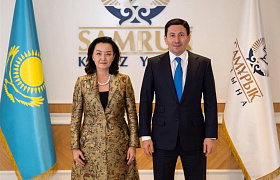
{{ $t('messages.news1') }}
Nurlan Zhakupov, Chairman of the Management Board of Samruk-Kazyna JSC...

{{ $t('messages.news1') }}
Gas Industry Development: QazaqGaz to Report on Results and Projects
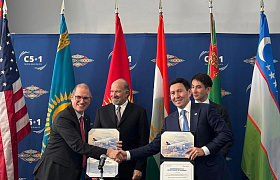
{{ $t('messages.news1') }}
A Number of Documents Signed by the Samruk-Kazyna Group during the Vis...


